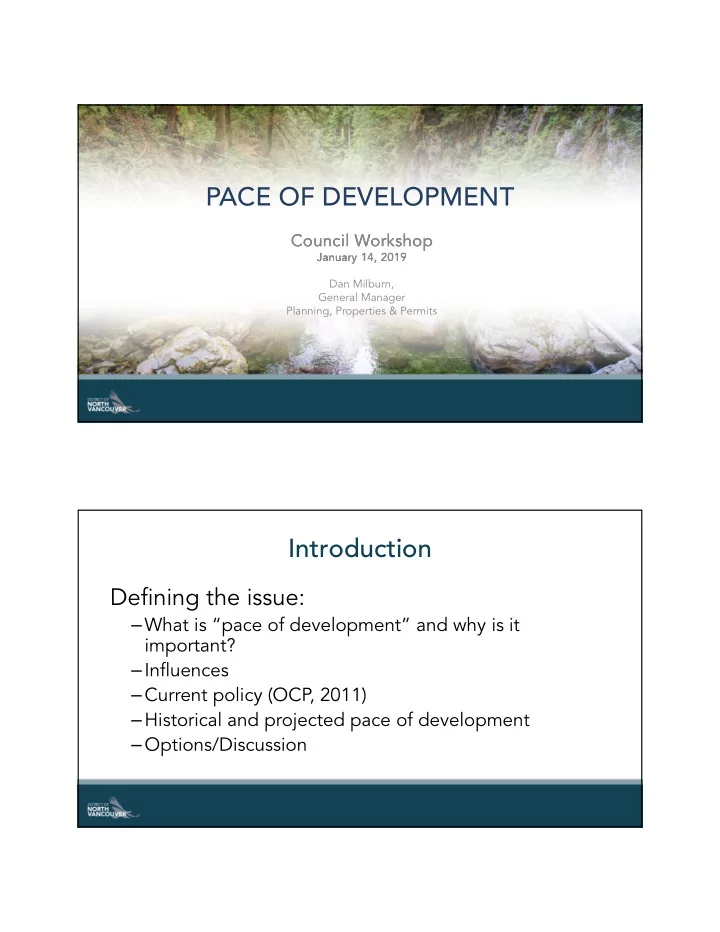

PACE OF DEVELOPMENT Council Workshop Council Workshop Council Workshop Council Workshop January 14, 2019 January 14, 2019 January 14, 2019 January 14, 2019 Dan Milburn, General Manager Planning, Properties & Permits Introduction Defining the issue: – What is “pace of development” and why is it important? – Influences – Current policy (OCP , 2011) – Historical and projected pace of development – Options/Discussion
Options for Active Rezoning Applications (i.e. instream): – Consider proposals on their individual merits – Focus on key town and village centres – Focus on rental housing, affordable housing and care facilities – Focus on proposals with significant transportation improvements What is “pace of development”? E.g. Residential units approved, E.g. Residential units approved, E.g. Residential units approved, E.g. Residential units approved, under construction or occupied per year under construction or occupied per year under construction or occupied per year under construction or occupied per year
What is “pace of development”? Occupation Acquisition and Applications and Area Planning Construction (absorption) decision making site planning 18 – 36 months 2 + years Days, months or 18 – 30 months months or years longer Compass Example: Horizon Seylynn Apex Village Beacon Beacon Horizon Compass Apex
Why is pace of development important? Change, uncertainty and risk (e.g. existing tenants) Construction impacts (e.g. noise, construction traffic) Land use impacts (e.g. traffic, character) Costs and service demands (e.g. capacity) Why is pace of development important? Changing community needs (e.g. aging population) Identified issues (e.g. housing diversity and affordability) Renewal and revitalization (e.g. asset life cycle)
What influences the pace of development? Demand: Demand Demand Demand : : : Supply Supply Supply Supply: : : : Population change Land supply - vacant, partially utilized, underutilized Employment change Market factors - speculation, holdings & settlements Interest rates Physical limits - environmental sensitivity, hazards Foreign Buyers Tax Policies - federal, provincial, regional, local Property Transfer Tax Regulations - Zoning School Tax Development review process Mortgage “stress-test” Census Growth Rate 2006 - 2011 Census Growth Rate 2011 - 2016 Port Moody Greater Vancouver A 19.9 24.2 Surrey 18.6 Langley, Township 12.6 Greater Vancouver A 18 Indian Reserves 11.2 Pitt Meadows 13.5 Surrey 10.6 New Westminster North Vancouver, City 12.7 9.8 Langley, Township Coquitlam 11.2 9.8 Coquitlam 10.4 Maple Ridge 8.2 Maple Ridge 10.3 New Westminster 7.6 Burnaby 10.1 Port Coquitlam 4.7 % Richmond Pitt Meadows 9.2 4.7 Port Coquitlam 6.9 Vancouver 4.6 North Vancouver, City 6.7 Burnaby 4.3 Langley, City 6.2 Richmond 4.1 Indian Reserves White Rock 6 3.2 Vancouver 4.4 Langley, City 3.2 Delta 3.3 Delta 2.4 White Rock 3.1 North Vancouver, District 1.8 North Vancouver, District 2.2 Port Moody 1.6 West Vancouver West Vancouver 1.3 -0.5 0 5 10 15 20 25 -5 0 5 10 15 20 25 30 DNV Projection (OCP) = 6% (actual 1.8%) Metro Vancouver = 9.3% Metro Vancouver = 6.5% BC = 7% BC = 5.6% Canada = 5.9% Canada = 5% Source: Statistics Canada Census
Current Policy (OCP , 2011) 2011 – 2030 + 10,000 homes (500/yr.) + 20,000 people (1,000/yr.) + 10,000 jobs (500/yr.) Planning Framework Not targets Housing Continuum
Housing Continuum Census Population and Projection: North Shore Municipalities 250,000 200,000 150,000 100,000 50,000 - 1951 1956 1961 1966 1971 1976 1981 1986 1991 1996 2001 2006 2011 2016 2021 2026 2031 DWV 13,990 19,197 25,454 31,987 36,440 35,754 35,728 36,266 38,783 40,844 41,421 42,131 42,694 42,473 51,000 53,500 56,000 CNV 15,687 19,951 23,656 26,851 31,847 31,934 33,952 35,698 38,436 41,475 44,303 45,165 48,196 52,898 56,000 59,000 62,000 DNV 14,469 26,252 38,971 48,124 57,861 63,471 64,904 68,241 75,157 80,418 82,310 82,562 84,412 85,935 98,000 101,000 105,000 Sources: Statistics Canada Census and Metro Vancouver 2040 Shaping Our Future
Census Population Change: North Shore Municipalities 25,000 20,000 15,000 10,000 5,000 - (5,000) 1956 1961 1966 1971 1976 1981 1986 1991 1996 2001 2006 2011 2016 2021 2026 2031 DWV 5,207 6,257 6,533 4,453 (686) (26) 538 2,517 2,061 577 710 563 (221) 3,325 3,325 3,325 CNV 4,264 3,705 3,195 4,996 87 2,018 1,746 2,738 3,039 2,828 862 3,031 4,702 3,450 3,450 3,450 DNV 11,783 12,719 9,153 9,737 5,610 1,433 3,337 6,916 5,261 1,892 252 1,850 1,523 5,000 5,000 5,000 Source: Statistics Canada Census Historical and Projected Pace of Development Single Family Multi-family
Single Family House construction and major renovations (over $150K) Under construction anytime in 2018 Source: DNV Single Family Houses: Date of Construction Source: DNV
Historical Pace of Rezoning Approvals and Multi-Family Occupancies • Net new multi-family residential units approved (i.e. rezoning) since OCP adoption = 4,456 (Average ~ 595/yr.) • Net new multi-family residential units occupied since OCP adoption = 1,646 (Average ~ 220/yr.) OCP Projection, and Cumulative Occupancy 10000 8000 6000 4000 5,248 2000 1,646
Type of Approved Projects 238 181 Non-Market Rental 598 Non-Market Care 61 Market Rental Market Care Market Ownership 4360 Type of Approved Projects 238 181 Non-Market Rental 598 Non-Market Care 61 Market Rental Larco - Market Rental, 341 Market Care Larco - Market Rental Market Ownership 4019
Type of Approved Projects 238 Non-Market Rental 181 598 Non-Market Care 61 Market Rental Larco - Market Rental, 341 Market Care Larco - Market Rental Secondary Rental, 804 Secondary Rental 3215 Market Ownership
Lions Gate-Marine Pace of Development Lions Gate - Marine
Lynn Valley Pace of Development Lynn Valley
Lynn Creek Pace of Development Lynn Creek
Maplewood Pace of Development Maplewood
Outside Centres Pace of Development Active Rezoning Applications (i.e. instream) Multi-Family Units
Options for Active Rezoning Applications (i.e. instream): – Consider proposals on their individual merits – Focus on key town and village centres – Focus on rental housing, affordable housing and care facilities – Focus on proposals with significant transportation improvements Thank you
Recommend
More recommend